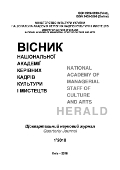M.M. SPERANSKY AS FOUNDER THE PRINCIPLE OF DIVISION OF THE AUTHORITIES IN RUSSIA (HISTORICAL AND LEGAL ANALYSIS)
DOI:
https://doi.org/10.32461/2226-3209.1.2018.178196Анотація
Abstract. This article is dedicated to the outstanding Russian statesman Mikhail Mikhailovich Speransky and his legal views. The paper focuses on the consideration of the principle of division of the authorities in the papers of Speransky. Of course, being the cornerstone of the rule of law, the principle of division of the authorities is of great practical importance for the modern Russian state. Mikhail Speransky, being one of the founders of the selection of this principle in Russian science, left a deep imprint on science. Considering the classical three-tier structure of principle division, the scientist and statesman Speransky worked out in detail the interaction mechanism of one governmental bodies with others. Unfortunately, most of his progressive ideas have not found a response in the circles of state power, however, they have not lost their relevance and value to this day. The value of Speransky's ideas was also in the scientist's desire to create a truly effective model of the rule of law. As an outstanding reformer, Speransky gave great importance to the role of civil society for the rule of law. The article also attempts to reveal the scientist's views from
the point of view of modern knowledge of the rule of law and its principles.
Key words: rule of law, civil society, principles of the rule of law, principle of division of the authorities,
system of checks and balances.
Посилання
Friendly Letters of Count M. M. Speransky to G. Masalsky, Written from 1798 to 1819, with Historical Explanations
Compiled by K. P. Masalsky, and Some Works of the First Youth of Count M. M. Speransky. St. Petersburg, 1962. P. 4-
Rae, John. Life of Adam Smith. — New York City: Macmillan Publishers, 1895.
Welcker К.Т. Die letzten Griinde von Recht, Staat und Strafe. Giesen, 1813. S. 25, 71 u.a.; Mohl R. Die
Polizeiwissenschaft nach den Grundsatzen des Rechtsstaates. Bd.l—2. Tubingen, 1832—1833.
Kassikhina V.E. M.M. Speransky, His Role in the Development and Formation of the Russian State and Law // State
and Law in the XXI Century. ― 2017. ― 2. ― P. 4-13.
Montesquieu, De l’esprit des lois, I, 1–2.
State Charter of the Russian Empire // Schilder, N. K. Emperor Alexander the First. His Life and Reign / N. K.
Schilder. – St. Petersburg, 1905. – V. IV. – P. 499-526.
The Constitution of the Russian Federation (adopted by popular vote on December 12, 1993) (taking into account the
amendments introduced by the Laws of the Russian Federation on Amendments to the Constitution of the Russian
Federation No. 6-FKZ dated December 30, 2008, No. 7-FKZ dated December 30, 2008, No. 2-FKZ dated February 5,
, No. 11-FKZ dated July 21, 2014).
Locke J. Two Treatises of Government // The works. – London, 1751. – V. II. – P. 103–238.
A.R. Gilmullin. On the Impact of Legal Doctrine on the Principles of Organization and Cctivity of the Mechanism of
the Russian State / World of Jurisprudence. ― 2017. ― No. 3. P. 18-53.
Bluntschli Johann Kaspar. The theory of state // Batoche Books, 2000. — 491 p.
Speransky М.М. Legal Works. Educational and Practical Manual. - М.: Zertsalo, 2008. - P. 281-284.
I. V. Ryzhitskaya. Codification Projects of Emperor Alexander I as an Integral Part of his Political Reforms / Power,
Society, Army. ― 2013. ― P. 130-139.
Formation of the State Council // Russian Legislation in the 10th – 20th Centuries. V. 6. М., 1988. P. 61.
Gilmullin Ainur, Krasnov Eduard, LEGAL DOCTRINE AS A SCIENTIFIC-THEORETICAL SYSTEM OF THE
STATE OF LAW//NATIONAL ACADEMY OF MANAGERIAL STAFF OF CULTURE AND ARTS HERALD. -
- Vol., Is.4. - P.329-332.
##submission.downloads##
Номер
Розділ
Ліцензія
Автори, які публікуються у цьому журналі, погоджуються з наступними умовами:
1. Автори залишають за собою право на авторство своєї роботи та передають журналу право першої публікації цієї роботи на умовах ліцензії Creative Commons Attribution License International CC-BY, котра дозволяє іншим особам вільно розповсюджувати опубліковану роботу з обов'язковим посиланням на авторів оригінальної роботи та першу публікацію роботи у цьому журналі.
2. Автори мають право укладати самостійні додаткові угоди щодо неексклюзивного розповсюдження роботи у тому вигляді, в якому вона була опублікована цим журналом (наприклад, розміщувати роботу в електронному сховищі установи або публікувати у складі монографії), за умови збереження посилання на першу публікацію роботи у цьому журналі.
3.Політика журналу дозволяє і заохочує розміщення авторами в мережі Інтернет (наприклад, у сховищах установ або на особистих веб-сайтах) рукопису роботи, як до подання цього рукопису до редакції, так і під час його редакційного опрацювання, оскільки це сприяє виникненню продуктивної наукової дискусії та позитивно позначається на оперативності та динаміці цитування опублікованої роботи.

